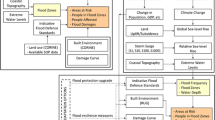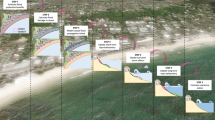Abstract
This paper studies the effects of mitigation and adaptation on coastal flood impacts. We focus on a scenario that stabilizes concentrations at 450 ppm-CO2-eq leading to 42 cm of global mean sea-level rise in 1995–2100 (GMSLR) and an unmitigated one leading to 63 cm of GMSLR. We also consider sensitivity scenarios reflecting increased tropical cyclone activity and a GMSLR of 126 cm. The only adaptation considered is upgrading and maintaining dikes. Under the unmitigated scenario and without adaptation, the number of people flooded reaches 168 million per year in 2100. Mitigation reduces this number by factor 1.4, adaptation by factor 461 and both options together by factor 540. The global annual flood cost (including dike upgrade cost, maintenance cost and residual damage cost) reaches US$ 210 billion per year in 2100 under the unmitigated scenario without adaptation. Mitigation reduces this number by factor 1.3, adaptation by factor 5.2 and both options together by factor 7.8. When assuming adaptation, the global annual flood cost relative to GDP falls throughout the century from about 0.06 % to 0.01–0.03 % under all scenarios including the sensitivity ones. From this perspective, adaptation to coastal flood impacts is meaningful to be widely applied irrespective of the level of mitigation. From the perspective of a some less-wealthy and small island countries, however, annual flood cost can amount to several percent of national GDP and mitigation can lower these costs significantly. We conclude that adaptation and mitigation are complimentary policies in coastal areas.




Similar content being viewed by others
References
Bender MA, Knutson TR, Tuleya RE, Sirutis JJ, Vecchi GA, Garner ST, Held IM (2010) Modeled impact of anthropogenic warming on the frequency of intense atlantic hurricanes. Science 327(5964):454–458
Bouwman AF, Kram T, Klein Goldewijk K (eds) (2006) Integrated modelling of global environmental change. An overview of IMAGE 2.4. Publication 500110002/2006, Netherlands Environmental Assessment Agency, Bilthoven, NL
CIESIN, CIAT (2004) Gridded Population of the World (GPW), Version 3. Center for International Earth Science Information Network and Columbia University and Centro Internacional de Agricultura Tropical and Palisades. CIESIN, Columbia University, NY
DINAS-COAST Consortium (2006) DIVA 1.5.5. Potsdam Institute for Climate Impact Research and Potsdam and Germany and CD-ROM
Dawson R, Dickson M, Nicholls R, Hall J, Walkden M, Stansby P, Mokrech M, Richards J, Zhou J, Milligan J, Jordan A, Pearson S, Rees J, Bates P, Koukoulas S, Watkinson A (2009) Integrated analysis of risks of coastal flooding and cliff erosion under scenarios of long term change. Clim Chang 95:249–288. doi:10.1007/s10584-008-9532-8
den Elzen MGJ, van Vuuren DP (2007) Peaking profiles for achieving long-term temperature targets with more likelihood at lower costs. PNAS 104(46):17,931–17,936. doi:10.1073/pnas.0701598104
Dugan JE, Hubbard DM (2006) Ecological responses to coastal armoring on exposed sandy beaches. Shore & Beach 74(1):10–16
Fankhauser S (1995) Protection versus retreat: the economic costs of sea-level rise. Environ Plan A 27(2):299–319
Hallegatte S, Ghil M (2008) Natural disasters impacting a macroeconomic model with endogenous dynamics. Ecol Econ 68:582–592
Hallegatte S, Hourcade JC, Dumas P (2007) Why economic dynamics matter in assessing climate change damages: illustration on extreme events. Ecol Econ 62(2):330–340
Hinkel J, Klein RJT (2009) Integrating knowledge to assess coastal vulnerability to sea-level rise: The development of the DIVA tool. Glob Environ Chang 19(3):384–395
Hinkel J, Bisaro S, Downing T, Hofmann ME, Lonsdale K, Mcevoy D, Tabara JD (2009) Learning to adapt. Narratives of decision makers adapting to climate change. In: Hulme M, Neufeldt H (eds) Making climate change work for us: European perspectives on adaptation and mitigation strategies. Cambridge University Press, Cambridge, pp 113–134
Hinkel J, Brown S, Exner L, Nicholls RJ, Vafeidis AT, Kebede AS (2011) Sea-level rise impacts on Africa and the effects of mitigation and adaptation: an application of DIVA. Reg Environ Chang 12:207–224. doi:10.1007/s10113-011-0249-2
Hof AF, den Elzen MGJ, van Vuuren DP (2008) Analysing the costs and benefits of climate policy: value judgements and scientific uncertainties. Glob Environ Chang 18(3):412–424. doi:10.1016/j.gloenvcha.2008.04.004
Hoozemans FMJ, Marchand M, Pennekamp HA (1993) Sea level rise: A global vulnerability assessment: Vulnerability assessments for population and coastal wetlands and rice production on a global scale, revised edn. Delft Hydraulics and Rijkswaterstaat. Delft Hydraulics and Rijkswaterstaat, Delft
Klein RJT, Nicholls RJ, Ragoonaden S, Capobianco M, Aston J, Buckley EN (2001) Technological options for adaptation to climate change in coastal zones. J Coast Res 17(3):531–543
Knutson TR, McBride JL, Chan J, Emanuel K, Holland G, Landsea C, Held I, Kossin JP, Srivastava AK, Sugi M (2010) Tropical cyclones and climate change. Nat Geosci 3(3):157–163
McFadden L, Spencer T, Nicholls RJ (2007) Broad-scale modelling of coastal wetlands: what is required? Hydrobiologia 577(1):5–15
Meinshausen M, Hare B, Wigley TML, van Vuuren D, den Elzen MGJ, Swart R (2006) Multi-gas emissions pathways to meet climate targets. Clim Chang 75:151–194
Meinshausen M, Meinshausen N, Hare W, Raper SCB, Frieler K, Knutti R, Frame DJ, Allen MR (2009) Greenhouse-gas emission targets for limiting global warming to 2° C. Nature 458:1158–1162
Menendez M, Woodworth PL (2011) Changes in extreme high water levels based on a quasi-global tide-gauge dataset. Journal of Geophysical Research under review
Nakicenovic N, Swart R (eds) (2000) Emissions scenarios. Special report of working group III of the intergovernmental panel on climate change. Cambridge University Press, Cambridge
Nicholls RJ (2002) Analysis of global impacts of sea-level rise: a case study of flooding. Phys Chem Earth 27(32–34):1455–1466
Nicholls RJ, Lowe JA (2004) Benefits of mitigation of climate change for coastal areas. Glob Environ Chang 14(3):229–244. doi:10.1016/j.gloenvcha. 2004.04.005
Nicholls RJ, Wong PP, Burkett VR, Codignotto JO, Hay JE, McLean RF, Ragoonaden S, Woodroffe CD (2007) Coastal systems and low-lying areas. In: Parry ML, Canziani OF, Palutikof JP, van der Linden PJ, Hanson CE (eds) Impacts and adaptation and vulnerability. Contribution of working group II to the fourth assessment report of the intergovernmental panel on climate change. Cambridge University Press, Cambridge, pp 315–356
Nicholls R, Hanson S, Brown S, Hinkel J (2010a) Economics of coastal zone adaptation to climate change. The World Bank Discussion Paper No. 10. Tech. rep., World Bank, Washington, DC
Nicholls RJ, Marinova N, Lowe JA, Brown S, Vellinga P, de Gusmao D, Hinkel J, Tol RSJ (2010b) Sea-level rise and its possible impacts given a “beyond 4 degree world” in the 21st century. Philos Trans R Soc Lond 369:161–181. doi:10.1098/rsta.2010.029
Peltier WR (2000) Global glacial isostatic adjustment and modern instrumental records of relative sea level history. In: Douglas BC, Kearney MS, Leatherman SP (eds) Sea-level rise. History and consequences. Academic, San Diego, pp 65–95
Rabus B, Eineder M, Roth A, Bamler R (2003) The shuttle radar topography mission: a new class of digital elevation models acquired by spaceborne radar. ISPRS J Photogramm Remote Sens 57(4):241–262
Rahmstorf S (2007) A semi-empirical approach to projecting future sea-level rise. Science 315:368–370
Tol RSJ (2006) The DIVA model: socio-economic scenarios and impacts and adaptation and world heritage. DINAS-COAST Consortium, 2006. DIVA 1.5.5. Potsdam Institute for Climate Impact Research, Potsdam, Germany, CD-ROM
Tol RSJ (2007) The double trade-off between adaptation and mitigation for sea level rise: an application of FUND. Mitig Adapt Strateg Glob Chang 12(5):741–753
Vafeidis AT, Nicholls RJ, McFadden L, Tol RSJ, Hinkel J, Spencer T, Grashoff PS, Boot G, Klein RJT (2008) A new global coastal database for impact and vulnerability analysis to sea-level rise. J Coast Res 24(4):917–924
van Vuuren DP, den Elzen MGJ, Lucas PL, Eickhout B, Strengers BJ, van Ruijven B, Wonink S, van Houdt R (2007) Stabilizing greenhouse gas concentrations at low levels: an assessment of reduction strategies and costs. Clim Chang 81:119–159
van Vuuren DP, Meinshausen M, Plattner GK, Joos F, Strassmann KM, Smith SJ, Wigley TML, Raper SCB, Riahi K, de la Chesnaye F, den Elzen MGJ, Fujino J, Jiang K, Nakicenovic N, Paltsev S, Reilly JM (2008) Temperature increase of 21st century mitigation scenarios. PNAS 105(40):15,258–15,262. doi:10.1073/pnas. 0711129105
van Vuuren DP, Isaac M, Kundzewicz ZW, Arnell N, Barker T, Criqui P, Berkhout F, Hilderink H, Hinkel J, Hof A, Kitous A, Kram T, Mechler R, Scrieciu S (2011) The use of scenarios as the basis for combined assessment of climate change mitigation and adaptation. Glob Environ Chang 21:575–591
Webster P, Holland G, Curry J, Chang H (2005) Changes in tropical cyclone number, duration, and intensity in a warming environment. Science 309(5742):1844
Wigley TML, Raper SCB (2001) Interpretation of high projections for global-mean warming. Science 293:451–454
Yohe G, Neumann J, Marshall P, Ameden H (1996) The economic cost of greenhouse-induced sea-level rise for developed property in the united states. Clim Chang 32(4):387–410
Acknowledgment
This work has been supported by the ADAM project funded by the European Commission’s Directorate-General Research from March 2006 to July 2009 (project reference: 18476). We thank Richard Tol, Lars Exner, Andries Hof, Morna Isaac as well as two anonymous reviewers for their support and very helpful comments on earlier versions of this paper.
Author information
Authors and Affiliations
Corresponding author
Rights and permissions
About this article
Cite this article
Hinkel, J., van Vuuren, D.P., Nicholls, R.J. et al. The effects of adaptation and mitigation on coastal flood impacts during the 21st century. An application of the DIVA and IMAGE models. Climatic Change 117, 783–794 (2013). https://doi.org/10.1007/s10584-012-0564-8
Received:
Accepted:
Published:
Issue Date:
DOI: https://doi.org/10.1007/s10584-012-0564-8




